Introduction
The relationship between environment and growth is a conventional theme in economics, (Stern (2004); Dinda (2004) and Dasgupta et al (2002)) so is the relationship between military effort and growth (Dunne and Birdi (2001); Dimitraki and Menla (2015); Dunne (2010)). However, there is almost no study that addresses the possible interactions between military effort, environment and growth. Although remarkable are the merits of the contributions proposed within these separate lines of studies, we argue that they don’t get grip on all the aspects of military effort. This lack of connection in research leaves many empty spaces between these different aspects, yet closely interacted. This article intends to contribute to fill this gap.
The purpose of this paper is to provide a rigorous examination of the links between pollution, military effort and growth. From this perspective, we argue that there are two mechanisms through which military effort, measured here through military expenditure, may impact pollution.
The first is a direct mechanism through which military expenditure directly impacts pollution. The second is the “indirect” mechanism by which military expenditure affects income which in turn impacts pollution. We assert that the total effect of military expenditure on pollution is the result of these two effects. As far as we know, prior contributions have neglected this indirect effect, which might significantly affect pollution. To empirically investigate these direct and indirect effects of military expenditure on pollution, we use a sample of 120 countries covering the period 1981 to 2015.
The remainder of the paper is organized as follows: section 2 examines the previous literature, section 3 outlines the methodology used within this paper, section 4 provides the results, and section 5 provides the conclusion.
The Literature Review
While the empirical studies on the relationship between environment and military effort are very limited, studies on the relationship between economic growth and military effort abound.
Table 1 provides the main contributions related to the relationship between military effort and economic growth.
Table 1: Effects of military expenditure on economic growth
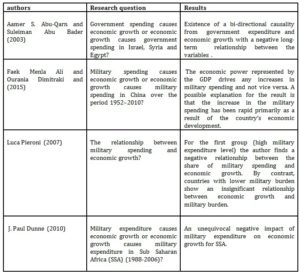
The Effects of Economic Growth on Environment
A large body of literature posits a link between pollution and economic growth. The seminal work of Krueger’s and Grossman (1991) detected the relationship known as the Environmental Kuznets Curve (EKC).
Table 2 examines the relation between pollution and economic growth.
Table 2: Effects of growth on pollution
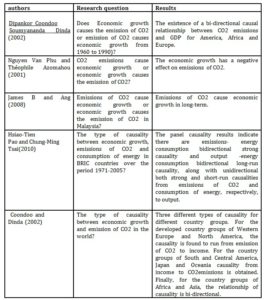
Methodology and data
Econometrically, the use of the multivariate cointegration is much recommended since it offers the opportunity to verify the existence of the relationship and the sense of causality among variables. It presents an extremely powerful empirical framework to deal with the issue raised in this paper.
In this study we will study the relationship between military expenditure and CO2emissions and specify the direct and indirect effect of military expenditure on the emissions of CO2.
Data
The data sample includes 4200 observations describing 120 different countries covering 35 years (from 1981 to 2015). We have used these countries because they have complete data for military expenditure variable and CO2emissions.
The indicator of military endeavour used in this paper is the military expenditure per capita (MILexp). Biswas and Ram (1986); Deger and Sen (1983); Faini Annez and Taylor (1984) and Leontief and Duchin (1983) used the military expenditure variable to study the link between military effort and economic growth.
The Empirical Strategy
Presentation of the Model
To handle both the indirect and direct effects of the military expenditure on pollution, we use the joint estimation of two equations. Estimation equations are defined as:

Where subscripts i and t denote country and year. In eq (1) emissions of CO2 per capita (ECO2) as a function of per capita income (GDP) and a quadratic income. Equation (1) also includes Z, a vector of additional explanatory variables. These include the share of exportation in GDP and the share of industry in GDP. Finally, γi and κt represent country and year specific effects, and εit and μit denote error terms.
Eq. (2) expresses per capita income as a function of year and country specific effects (τt and λi), military expenditure (MILexp) and X, a vector of other explanatory variables.
Instrumental variables
In equation (2) income is a function of military expenditure ; consequently this equation may suffer from a problem of endogeneity. To deal with this potential endogeneity, in this equation MILexp is instrumented. The instrumental variable solution is to find another variable; this variable is highly correlated with MILexp, and not correlated with the error term. We use the Human Development Index.
Table 3 presents the descriptive statistics of these variables
Table3: Definition of the variables and descriptive statistics
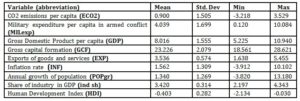
Identifying the effect of the military expenditure on pollution
The total effect of military expenditure per capita on emissions of CO2 (dECO2/ dMILexp) decomposes into a direct and an indirect effect. The direct effect is defined as the impact of military expenditure on emissions of CO2. The indirect effect is expressed as the product of the impact of military expenditure on income (δY/ δMILexp) and the impact of income on emissions of CO2 (δECO2/ δY). These effects can be expressed as:

Where ECO2, Y and MILexp denote emissions of CO2, income and military expenditure, respectively.
Empirical Results
Estimation Results
Table 4 provides estimates of per capita income equation.
Table 4: The impact of military expenditure per capita on per capita income
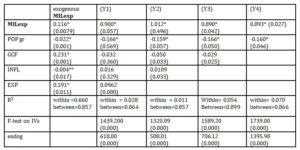
In the first column, military expenditure is treated as being exogenous with regard to income and is therefore not instrumented. In models Y1 to Y4 Military expenditure is instrumented using 2SLS. All models use a random effects specification.* and ** denote significance at 5% and 10% respectively.
Table 4 provides estimates of per capita income equation. In the first column, MIL which is treated as being exogenous with regard to income is not instrumented, but in all subsequent columns MIL is instrumented. Model (Y4) begins by expressing per capita income simply as a function of population growth and military expenditure. Models (Y1) to (Y3) include explanatory variables used by many studies (Levine and Zervos (1993); Mankiw et al (1992) and Levine and Renelt (1992)).These variables are the population growth rate (POPgr), the rate of inflation (INFL), and the share of exports in GDP.
In Table 4, Military expenditure is found to have a statistically positive impact on income in all models. This result is justified by Benoit (1973) but contradicts with other contributions (Leontief and Dutchin (1983); Deger and Sen (1983) and Taylor et al (1984)).
The correlation between MILexp and the instrument (IDH) is high whereas the correlation between the residuals of the model (Y1) and the instrument is very low (See table A2). The first stage regression results validate the use of variables “IDH” as instruments (See table A3) . The obtained F value is high and the first stage estimates are significant (see Table A3). This gives extra support to the validity of the instrument (IDH).
Table 5: Estimates of per capita pollution emissions based on model (Y1)
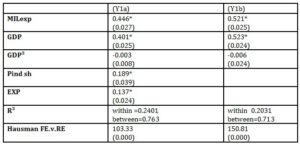
Standard errors in parentheses.* denotes significance at 5% respectively. All models use a fixed effect
Table 5 provides estimates of per capita CO2 emissions, utilizing the results of the ‘full’ income models (Y1) (see table3). A ‘basic’ equation is estimated (models Y1b) where pollution is expressed simply as a function of per capita income and military expenditure. In all models MILexp has a positive and statistically significant effect on emissions of CO2. Industry share (INDsh) and export of goods and services (EXP) are found to be positive, significant determinants of pollutant emission. In this direction, Managi (2004) shows that trade liberalization causes the increase of emissions of CO2. In the same context, Tubb and Magnani (2007) and Cole (2004) argue that trade affects negatively emissions of many pollutants (CO2, SO2, NO2 etc…) in OECD countries.
It is now possible to quantify the impact of military expenditure on emissions of CO2. Firstly, Table 6 provides the indirect, direct and total effect of military expenditure on pollution for each of the two models presented in Table 5.
Table 6: The impact of military expenditure on pollution

Table 6 indicates a positive direct impact of military expenditure on emissions of CO2. For emissions of CO2, the indirect effect is positive, providing a positive total effect.
This positive sign of indirect effect reflects the same sign of the relationship between income and emissions of CO2 income (δECO2/δY) and the relationship between income and military expenditure (δY/ δMILexp). Consequently, a military expenditure – induced reduction in income leads to a reduction in emissions of CO2 and vice versa.
Discussions and conclusions
The aim of this paper is to study the relationship between emissions of CO2 and military endeavor with a detailed empirical examination.
Empirical results show that military expenditure has a positive indirect and direct effect on per capita CO2emissions. This positive linkage between the two variables was found to increase statistical significance when military endeavor was instrumented as a determinant of income.
A direct consequence of our results is that a reduction of military endeavor entails a reduction of emissions of CO2 and vice versa.
Appendix
Table A1. Data Information
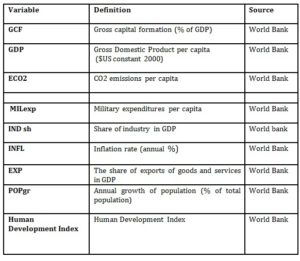
Table A2: Correlation matrix
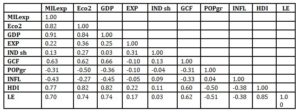
Table A3: First stage estimations of military expenditure
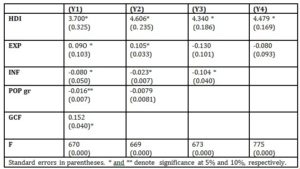
(adsbygoogle = window.adsbygoogle || []).push({});
References
- Abu-Bader, S. and Abu-QarnS. (2003) ‘Government Expenditures, Military Spending and Economic Growth: Causality Evidence from Egypt, Israel and Syria,’ Policy Modeling 25 (6-7),567-583.
- Ang, James.B. (2008) ‘What are the mechanisms linking financial development and economic growth in Malaysia,’ Economic Modelling, 25(1), 38-53.
- Azomahou, T. , Laisney, F. and Van Phu, N. (2006) ‘ Economic Development and CO2 emissions: a nonparametric panel approach,’ Journal of Public Economics, 90,1347-1363.
- Azomahou, T. and Nguyen, V.Ph. (2001) ‘Economic growth and CO2 emissions: A non parametric approach’, CORE Discussion Papers Series No.2001012, Université Catholique de Louvain, Center for Operations Research and Econometrics (CORE).
- Benoit, E. (1973) Defense Spending and Economic Growth in Developing Countries, Lexington: Lexington Books .
- Benoit, E. (1978) ‘Growth and Defense Spending in Developing Countries,’ Economic Development and Cultural Change, 26 (2), 271-280.
- Birdi, A. and Dunne, P. (2001) ‘An Econometric Analysis of Military Spending and Economic Growth in South Africa,’ Middlesex University Business School (2001).
- Biswas, B. and Ram, R. (1986) ‘Military Expenditures and Economic Growth in Less Developed Countries: An Augmented Model and Further Evidence,’ Economic Development and Cultural Change, 34(2), 361–372.
- Cole, MA. (2004) ‘Trade, the pollution haven hypothesis and the environmental Kuznets curve: examining the linkages,’ Ecological Economics, 48(1), 71-81.
- Cole, MA. (2007) ‘Corruption, Income and the Environment: An Empirical Analysis,’ Ecological Economics, 62(3), 637-647.
- Coondoo, D. and Dinda, S. (2002) ‘Causality between income and emission: a country group-specific econometric analysis,’ Ecological Economics, 40(3), 351-367.
- Coondoo, D. and Dinda, S. ‘2006) ‘Income and emission: A panel data-based cointegration analysis,’Ecological Economics, Elsevier, 57(2), 167-181.
- Dasgupta, S., Laplante, B., Wang, H. and Wheeler, D. (2002) ‘Confronting the environmental Kuznets curve,’ Economic Perspectives,16 (1) ,147-168.
- Deger, S. and Sen, S. (1983) ‘Military Expenditure, Spin-off and Economic Development,’ Development Economics, 13(1-2), 67-83.
- Dimitrakiand ,O. and Menla Ali, F. (2015) ‘The Long-run Causal Relationship Between Military Expenditure and Economic Growth in China,’ Defence and Peace Economics,26(3), 311-326.
- Dinda, S. and Coondoo, D. (2002) ‘Income and Emission: A Panel Data based Cointegration Analysis,’ Ecological Economics, 57 (2), 167-181.
- Dinda, S. (2004) ‘Environmental Kuznets curve hypothesis: a survey,’ Ecological Economics, 49(4), 431–455.
- Dunne , J.P. (2010) ‘Military Spending and Economic Growth in Sub Saharan Africa’ School of Economics, University of the West of England, Bristol BS16 1QY, UK and SALDRU, University of Cape Town(2010).
- Fiani, R . Annez, P. and Taylor, L. (1984) ‘Defense Spending, Economic Structure and Growth: Evidence among Countries and Over Time,’ Economic Development and Cultural Change, 32(3), 487-498.
- 20. Grossman, G.M. and Krueger ,A.B . (1991) ‘ Environmental Impacts of North American Free Trade Agreement’, Working Paper Series No. 3914, national Bureau of Economic Research,USA .
- Leontief, W. and Duchin, F. (1983) ‘Military Spending: Facts and Figures, Worldwide Implications and Future Outlook’, New York: Oxford University Press.
- Levine, R. and Renelt, D. (1992) ‘A sensitivity analysis of cross-country growth regressions,’ American Economic Review, 82(4), 942 -963.
- Levine, R. and Zervos, S.J. (1993) ‘What we have learned about policy and growth from cross-country regressions?’ American Economic Review Papers and Proceedings, 83(2), 426- 430
- Magnani, E. and Tubb, A. (2007) ‘ The Link Between Economic Growth and Environmental Quality: Does Population Ageing Matter?’, Discussion Paper No. 12 , School of Economics, Australia (2007).
- Managi, (2004) ‘Trade Liberalization and the Environment: Carbon Dioxide for 1960-1999,’Economics Bulletin, 17 (1), 1-5.
- Mankiw, N.G., Romer, D. and Weil, D.N. (1992) ‘A contribution to the empirics of economic growth,’Quarterly Journal of Economics, 107(2), 407-437.
- Pao, H. and Tsai, C. (2010) ‘CO2 emissions, energy consumption and economic growth in BRIC countries,’ Energy Policy, 38(12), 7850-7860.
- 29. Stern, D. (2007) ‘The rise and fall of the environmental kuznets curve,’ World Development, 32(8), 1419-1439.
- 30. Welsch, H. (2004) ‘Corruption, growth and the environment: a cross-country analysis,’ Environment and Development Economics, 9(5), 663–693.













